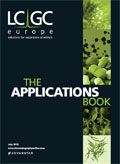Molar Mass Determination of Gelatins Using GPC/SEC
PSS Application Note
Gelatin is a polypeptide produced from hydrolysis of collagens in skin and bones. It is obtained from acidic or from basic hydrolysis and contains poly amino acids. Gelatin is used in the food and beverage industry and in the pharmaceutical industry as a stabilizer for tablets and for many other applications.
Sample Preparation
The isoelectric point of the basic produced gelatin is between 4.7 and 5.2; the acidic produced gelatin has an isoelectrical point of 7.5 to 9.3. Basic produced gelatin can be easily measured using standard conditions (see PSS Application notes 10271 and 10272). Gelatin with an isoelectric point between 7 and 9 must be measured using low pH values or at pH-values > 9 (not recommended) in order to achieve sufficient solubility.
The following experimental conditions can be applied to gelatins independent of their isoelectric point and the hydrolysis process.
However, exact sample preparation following a strict protocol is a crucial step for the GPC/SEC analysis of gelatins.

Figure 1: Overlay of 3 different gelatins from Carl Roth Chemicals, Karlsruhe, Germany.
Experimental
GPC/SEC analysis was performed on a PSS SECcurity GPC System comprising:
- an isocratic pump
- an autosampler with variable injection volume
- a DAD detector operated at a fixed wavelength 214 nm +/- 4 nm
The analysis conditions were:
Columns: PSS PROTEEMA, 5µm, 1000 Å, 300 Å, 100 Å (8 × 300 mm each) + precolumn
Solvent: Phosphate buffer pH 5.5 (acidic gelatin) to 6.6 (basic gelatin) + 0.2 M NaCl + 0.5% SDS
Flow-rate: 0.5 mL/min – 1 mL/min
Temperature: Room temperature
Calibration: PSS Pullulan kit, 10 standards: 342–710000 Da (alternative: PSS Poly(styrene sulfonate) sodium salt kit, 10 standards: 100–1000000 Da)
Concentration: 2 g/L
Inject volume: 100µL
Data acquisition, calibration and evaluation: PSS WinGPC UniChrom 8.0
Results and Conclusion
Figure 1 shows the measured molar mass distribution for three different gelatins. Reproducible and easy-to-use GPC/SEC analysis for all types of gelatins can be done using a SECcurity GPC system, PROTEEMA columns and a solvent with a pH of 5.5 for acidic and 6.6 for basic produced gelatin. Data analysis was done using WinGPC UniChrom.
Software solutions for advanced detection (e.g., triple detection), simultaneous molar mass analysis of up to 8 regions and 21CFR11 compliant analysis are also available.
PSS Polymer Standard Servive GmbH
In der Dalheimer Wiese 5, 55120 Mainz, Germany
tel. +49 6131 96239 0 fax +49 6131 96239 11
E-mail: info@polymer.de Website: www.pss-polymer.com

New Study Reviews Chromatography Methods for Flavonoid Analysis
April 21st 2025Flavonoids are widely used metabolites that carry out various functions in different industries, such as food and cosmetics. Detecting, separating, and quantifying them in fruit species can be a complicated process.
Analytical Challenges in Measuring Migration from Food Contact Materials
November 2nd 2015Food contact materials contain low molecular weight additives and processing aids which can migrate into foods leading to trace levels of contamination. Food safety is ensured through regulations, comprising compositional controls and migration limits, which present a significant analytical challenge to the food industry to ensure compliance and demonstrate due diligence. Of the various analytical approaches, LC-MS/MS has proved to be an essential tool in monitoring migration of target compounds into foods, and more sophisticated approaches such as LC-high resolution MS (Orbitrap) are being increasingly used for untargeted analysis to monitor non-intentionally added substances. This podcast will provide an overview to this area, illustrated with various applications showing current approaches being employed.

.png&w=3840&q=75)

.png&w=3840&q=75)



.png&w=3840&q=75)



.png&w=3840&q=75)















